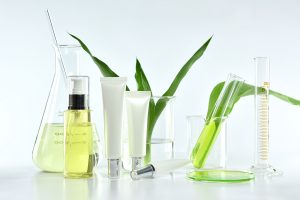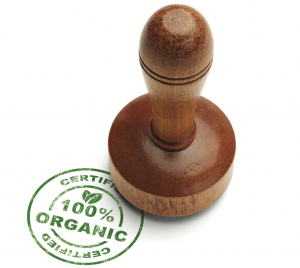CERTIFIED ORGANIC ESSENTIAL OILS – MYTH OR REALITY? January 18, 2019
The United States Department (USD) Agricultural Marketing Service (AMS) implemented the organic regulations in 2002. The US organic sector has tripled in size since then. Retail sales now exceed $43 billion and there are over 22,000 certified organic operations. Strong consumer demand outruns supply providing market opportunities within the organic sector.
 Certified organic essential oils are not just free of pesticides. Organic production enhances biodiversity, biological cycles, and microbe-rich soil.
Certified organic essential oils are not just free of pesticides. Organic production enhances biodiversity, biological cycles, and microbe-rich soil.
Organic soil can also influence climate change. Carbon-rich soils are like sponges, absorbing water during floods and releasing it during drought. Damaged soils release carbon dioxide. Plant-covered soil, crop diversity, composting, and planned grazing puts carbon back into soils.
Certified organic essential oils need the entire production chain to be free of pesticides. The USDA provides a list of permitted chemicals. Fertilizers made with synthetic ingredients, or sewage sludge are not permitted. Genetically modified organisms (GMOs) are prohibited in organic production. Likewise, any post-harvest, ionizing or radiation before processing is not allowed.
Organic farms producing organic essential oils are inspected by a USDA-accredited certifier to enforce organic standards. Only authorized certified organic handlers may distill, extract, process, import or export certified organic essential oils. Organic handlers, processors, and retailers all adhere to these standards.
“Silent Spring” by Rachel Carson, founder of the environmental movement in the 1960s, appealed to readers to use pesticides with care, and act as stewards of a living earth. Her message of sharing responsibilities of stewardship is still at the heart of the organic philosophy. This includes the protection of natural resources, biodiversity, and the entire ecosystem. Pesticide-free is a powerful commitment and a great starting point for an essential oil producer.
Fast forward to organic on steroids. Biodynamic farming was founded on the celestial interconnectivity theories and beliefs of visionary Rudolf Steiner. His approach to the importance of stewardship in agriculture was like Carson’s. A biodynamic farm is a unique living biosphere. Water conservation and biodiversity are key.
Biodynamics, in the background since the 1920s, has recently gained popularity and market share. Companies like Eminence, producers of certified organic,  biodynamic skin care products are leaders. Demeter, a global organization manages biodynamic certification.
biodynamic skin care products are leaders. Demeter, a global organization manages biodynamic certification.
Despite evidence that certified organic and pesticide free are optimal for the planet there is still doubt about organic validity and value. Balancing the bottom line and committing to producing certified organic essential oils is a challenge.
Essential oil companies that offer certified organic are focusing on data trends. Consumers are driving the upswing with their wallets. In 2017 China had a 19% growth in organic market offerings. American consumers favor holistic approaches, organic, simple ingredients, no artificial additives, non-GMO and pesticide free. They want flavor and fragrance to be another source of wellness, along with the organic food they eat.
Even mainstream fragrance houses are going back to their roots using organic plant-sourced aroma materials. Guerlain‘s image provides a story of transparent natural ingredients sourced from “field to flacon”.
 Transparent sustainability, environmentalism, the certified organic movement, the rise of veganism9 and workforce welfare; these social forces are driving buying decisions in the flavor, fragrance, and aromatherapy markets.
Transparent sustainability, environmentalism, the certified organic movement, the rise of veganism9 and workforce welfare; these social forces are driving buying decisions in the flavor, fragrance, and aromatherapy markets.
But does an organic certificate guarantee a pesticide-free product? Pesticide residue is a global wall-to-wall carpet. Pesticides have been around since the late 1930s. Many take a long time to degrade in the environment resulting in global saturation. Every living organism has a DDT body burden, mainly stored in fat. Evidence reveals that DDT has endocrine-disrupting potential; carcinogenic action; and exposure in-utero leads to a host of development problems.
Despite organic practices used to reduce residues, environmental pesticide poisoning and use continues. Organic agriculture practices cannot ensure that products are completely free of pesticide residues. If a certified organic essential oil contains pesticides, we assume that the source was a result of unintentional contamination. Organic production requires the soil to have at least three years with no direct application of, or contact with, pesticides.
Ideally, all certified organic essential oil producers would provide a lot-specific pesticide analysis. In the US a pesticide test costs around $360. This is a large expense for smaller aromatherapy, retail or product manufacturing companies.
Any pesticides identified in a certified organic essential oil creates an ethical and fiscal dilemma. While there are yet no maximum acceptable levels (MRLs) of pesticides for essential oils many products classed as food or medicinal products have MRLs based on the acceptable daily intake. Global organizations including the World Health Organization (WHO), The European Pharmacopoeia, The United Nations (UN), and the Food and Agriculture Organization (FAO) are all involved in setting MRLs. The Codex Alimentarius Commission was established in 1961 to develop a code of food quality standards.The database is online but it is not easily accessed or intuitive. These MRLs impact the flavor, fragrance, aromatherapy trade as the figure below illustrates.
FIGURE 1 MRLS IN EDEIBLE CITRUS OIL

The USA has a similar database, the Global MRL database which is more intuitive than the Codex Alimentarius. The basic subscription level is free.
Soil to oil is a trademark phrase used by many essential oil vendors.14 Yet is soil necessary to categorize an aromatic plant as certified organic? Could aromatic plants be grown indoors, hydroponically or bioponically, (the organic version of hydroponics), protected from pesticides and still carry the organic label? Certification of hydroponic, aquaponic, and aeroponic operations is allowed under USDA organic regulations. To be labeled as organic, the operation must be certified by a USDA-accredited certifying agent and maintain compliance with regulations. (L. W. Zhang, Public Affairs Office Agricultural Marketing Service U.S. Department of Agriculture, email, October 9th, 2018). Once certified, the product states that it “Meets USDA Organic Requirements.” Would the end-product of this production method be an acceptable source of essential oils? Particularly if the crop is shielded from global pesticide contamination? That remains to be seen.
INTEGRITY – IS ORGANIC JUST A FAKE CERTIFICATE?
Certified organic oils fetch a higher price. It is illegal to use the word “organic” on any product, if it does not meet the standards set by law. Enforcement is strict. Fraudulent use of the term “certified organic” or “organic” results in a financial penalty for each incident, loss of credibility, and a listing in a revoked or suspended database published by the USDA. The USDA maintains a downloadable list of fraudulent certificates. There are 112 companies on the list. If an organic certificate appears fraudulent, it is prudent to reach out to the certifying agency. It is also possible to submit a complaint to the National Organic Program (NOP).
GLOBAL ORGANIC STANDARDS
Global organic standards provide a more protective global environmental bubble and increase the ease of trade. The United States currently has organic equivalency agreements with the European Union, Korea, Switzerland, Taiwan, Canada, and Japan. Certified organic products can be imported and exported between the US and these countries.
 Also, the US has recognition agreements with countries such as India. Recognition agreements allow a foreign government to accredit certifying agents in that country to the USDA organic standards. A list of those certifying agencies can be reviewed and products certified as organic by these agencies can be imported into the US as certified organic.
Also, the US has recognition agreements with countries such as India. Recognition agreements allow a foreign government to accredit certifying agents in that country to the USDA organic standards. A list of those certifying agencies can be reviewed and products certified as organic by these agencies can be imported into the US as certified organic.
The efforts to move towards a global standard continue and as part of their work towards organic equivalency, the United States and Mexico have formed a Joint U.S.-Mexico Organic Compliance Committee to monitor and enforce controls on organic products traded between the two countries.
WHY BOTHER WITH ORGANIC?
The question is still asked: “Is organic really better?” A 2014 study with vetiver Vetiveria zizanioides (L.) Nash certified organic essential oil concluded that the fresh root was denser and more appealing, and the yield and constituent profile were superior to the conventional vetiver. While this is not true for all essential oils the positive impact of organic production is far-reaching. If dire environmental degradation is not persuasive enough, look at the positive financial impact of the organic trend. In June 2018, Zion Market Research published a report on the organic forecast through the year 2024. The global organic food and beverages market was valued at approximately USD 124.76 billion in 2017 and is expected to generate revenue of around USD 323.09 billion by the end of 2024, a compound annual growth rate of around 14.56% between 2017 and 2024.
Dorene Petersen, ND (NZ), DIP.ACU, RH (AHG)
 Ultra International B.V.
Ultra International B.V.